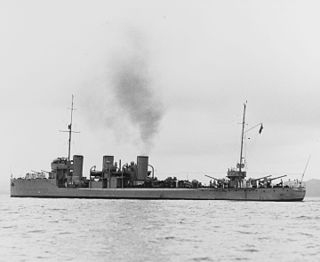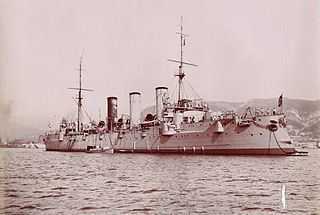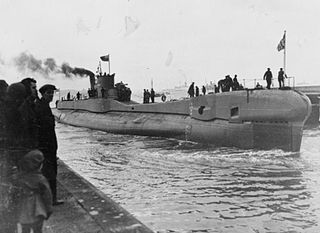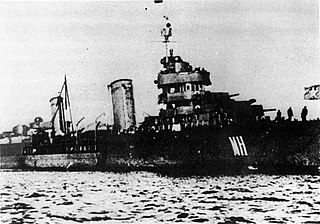
Petropavlovsk was the third of the four Gangut-class dreadnoughts built before World War I for the Imperial Russian Navy, the first Russian class of dreadnoughts. She was named after the Russian victory in the siege of Petropavlovsk during the Crimean War. The ship was completed during the winter of 1914–1915, but was not ready for combat until mid-1915. Her role was to defend the mouth of the Gulf of Finland against the Germans, who never tried to enter, so she spent her time training and providing cover for minelaying operations. Her crew joined the general mutiny of the Baltic Fleet after the February Revolution of 1917 and she was the only dreadnought available to the Bolsheviks for several years after the October Revolution of 1917. She bombarded the mutinous garrison of Fort Krasnaya Gorka and supported Bolshevik light forces operating against British ships supporting the White Russians in the Gulf of Finland in 1918–1919. Later, her crew joined the Kronstadt Rebellion of 1921 and she was renamed Marat after the rebellion was crushed.

The Bogatyr class were a group of protected cruisers built for the Imperial Russian Navy. Unusually for the Russian navy, two ships of the class were built for the Baltic Fleet and two ships for the Black Sea Fleet.

Novík was a destroyer of the Russian Imperial Navy and Soviet Navy, commissioned in 1913 where she served with the Baltic Fleet during World War I. She joined the Bolsheviks in November 1917 and was renamed Yakov Sverdlov in 1923. She was a training ship when Operation Barbarossa began, but was recalled to active duty the following day. She struck a mine on 28 August 1941 and sank while escorting an evacuation convoy during the Soviet evacuation of Tallinn.

The Leninets or L class were the second class of submarines to be built for the Soviet Navy. Twenty-five were built in four groups between 1931 and 1941. They were minelaying submarines and were based on the British L-class submarine, HMS L55, which was sunk during the British intervention in the Russian Civil War. Some experience from the previous Dekabrist-class submarines was also utilised. The boats were of the saddle tank type and mines were carried in two stern galleries as pioneered on the pre-war Russian submarine Krab (1912). These boats were considered successful by the Soviets. Groups 3 and 4 had more powerful engines and a higher top speed.

The Shchuka-class submarines, also referred to as Sh or Shch-class submarines, were a medium-sized class of Soviet submarines, built in large numbers and used during World War II. "Shchuka" is Russian for pike. Of this class, only two submarines entered service after 1945, although they were launched before the war.

The British campaign in the Baltic 1918–1919 was a part of the Allied intervention in the Russian Civil War. The codename of the Royal Navy campaign was Operation Red Trek. The intervention played a key role in enabling the establishment of the independent states of Estonia and Latvia. It failed to secure the control of Petrograd by White Russian forces, which was one of the main goals of the campaign.

The Morzh-class submarines were built for the Black Sea Fleet of the Imperial Russian Navy shortly before World War I.

The Sarancha class is the NATO reporting name for a hydrofoil missile boat built for the Soviet Navy. The Soviet designation was Project 1240 Uragan.

BAP Almirante Guise was a destroyer that served in the Russian, Estonian, and Peruvian navies from 1917 to 1954. She was a rebuilt type of the Izyaslav class. Originally named Avtroil while in Russian service, in 1918 she was captured by Royal Navy and handed over to Estonia where she was renamed Lennuk. The ship participated in the Estonian War of Independence, and served with the Estonian Navy until 1933, when she was sold to Peru where she was renamed Almirante Guise.

The cruiserBogatyr, launched 1901, was the lead ship of the Bogatyr class of four protected cruisers built between 1898 and 1907 for the Imperial Russian Navy.

Kommuna is a submarine rescue ship in service with the Russian Navy's Black Sea Fleet and the world's oldest active duty naval vessel.

The Barents Sea campaign in 1941 was a submarine operation in the Arctic waters of the Barents Sea during World War II. It was a combined Soviet and British campaign, with boats departing from Polyarny to harass German shipping along the Norwegian coast.

Minsk was one of six Leningrad-class destroyer leaders built for the Soviet Navy during the 1930s, one of the three Project 38 variants. Completed in 1939, the ship was assigned to the Baltic Fleet and played a minor role in the Winter War against Finland in 1939–1940. After the start of Operation Barbarossa, the German invasion of the Soviet Union in June 1941, Minsk covered minelaying operations and provided naval gunfire support to Soviet units. She escorted ships during the Soviet evacuation of Tallinn, Estonia, in late August. The ship was sunk by German dive bombers on 23 September, although her wreck was salvaged in 1942 and repaired. Minsk was recommissioned in 1943 but the repairs were not completed until the following year. The ship was reclassified as a training ship in 1951, then became a target ship in 1958 and was sunk that year.

Gavriil was an Orfey-class destroyer of the Russian Imperial Navy. The destroyer was built by the Russo-Baltic Yard at Reval, launching on 5 January 1915 and completing in October 1916. She served with the Baltic Fleet during the remainder of the First World War, and after the October Revolution joined the Bolshevik Red Fleet. She was active during the Russian Civil War, taking part in several engagements against British ships during the British campaign in the Baltic, and was sunk by a mine on 21 October 1919.

Azard was one of eight Orfey-class destroyers built for the Russian Imperial Navy during World War I. Completed in 1916, she served with the Baltic Fleet and joined the Bolshevik Red Fleet after the October Revolution of 1918. She was active during the Russian Civil War, taking part in several engagements against British ships during the British campaign in the Baltic. The destroyer was renamed Zinoviev in 1922 and Artem in 1928. She remained in service with the Soviet Baltic Fleet when Germany invaded the Soviet Union in 1941, and was sunk by a mine on 28 August.
Izyaslav was the lead ship of her class of five destroyers built for the Russian Imperial Navy during the 1910s. Completed during 1916, she served with the Baltic Fleet during the remainder of the First World War, and after the October Revolution joined the Bolshevik Red Fleet. She was active during the Russian Civil War, taking part in several engagements against British ships during the British campaign in the Baltic. The destroyer was renamed Karl Marx in 1922. She played a small role in the Winter War with the Soviet Baltic Fleet when Germany invaded the Soviet Union in 1941, and was sunk by German aircraft on 8 August 1941.

Samson was one of eight Orfey-class destroyers built for the Russian Imperial Navy during World War I. Completed in 1916, she served with the Baltic Fleet and joined the Bolshevik Red Fleet after the October Revolution of 1918. She was active during the Russian Civil War, taking part in several engagements against British ships during the British campaign in the Baltic. The destroyer was renamed Stalin in 1922. She was assigned to the Pacific Fleet when Germany invaded the Soviet Union in 1941 and saw little to no combat. The ship was scrapped in 1953.

Desna was one of eight Orfey-class destroyers built for the Russian Imperial Navy during World War I. Completed in 1916, she served with the Baltic Fleet and joined the Bolshevik Red Fleet after the October Revolution of 1918. She was active during the Russian Civil War, taking part in several engagements against British ships during the British campaign in the Baltic. The destroyer was renamed Engels in 1922. She remained in service with the Soviet Baltic Fleet when Germany invaded the Soviet Union in 1941, and was sunk on 24 August.

Pobeditel was one of eight Orfey-class destroyers built for the Russian Imperial Navy during World War I. Completed in 1915, she served with the Baltic Fleet and joined the Bolshevik Red Fleet after the October Revolution of 1918. She was active during the Russian Civil War, taking part in several engagements against British ships during the British campaign in the Baltic. The destroyer was renamed Volodarski in 1922. She remained in service with the Soviet Baltic Fleet when Germany invaded the Soviet Union in 1941, and was sunk on 28 August.

Zabiyaka was one of eight Orfey-class destroyers built for the Russian Imperial Navy during World War I. Completed in 1916, she served with the Baltic Fleet and joined the Bolshevik Red Fleet after the October Revolution of 1918. She was active during the Russian Civil War, taking part in several engagements against British ships during the British campaign in the Baltic. The destroyer was renamed Uritski in 1922. She was assigned to the Baltic Fleet when Germany invaded the Soviet Union in 1941, and survived the war to be scrapped in 1953.














